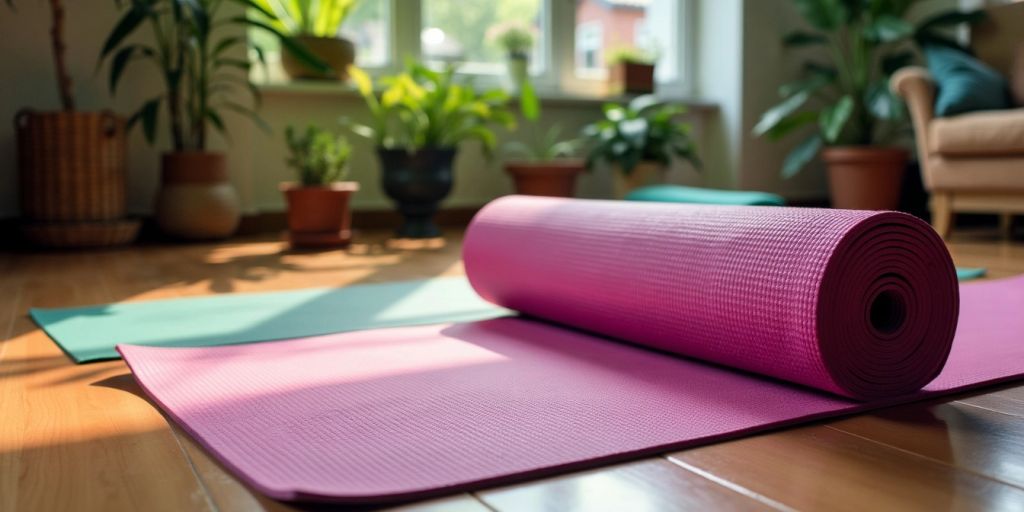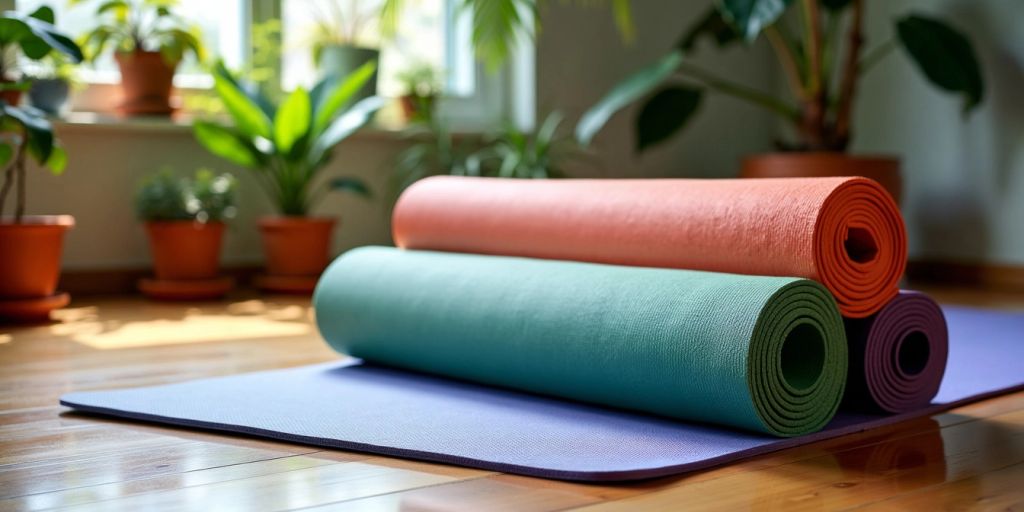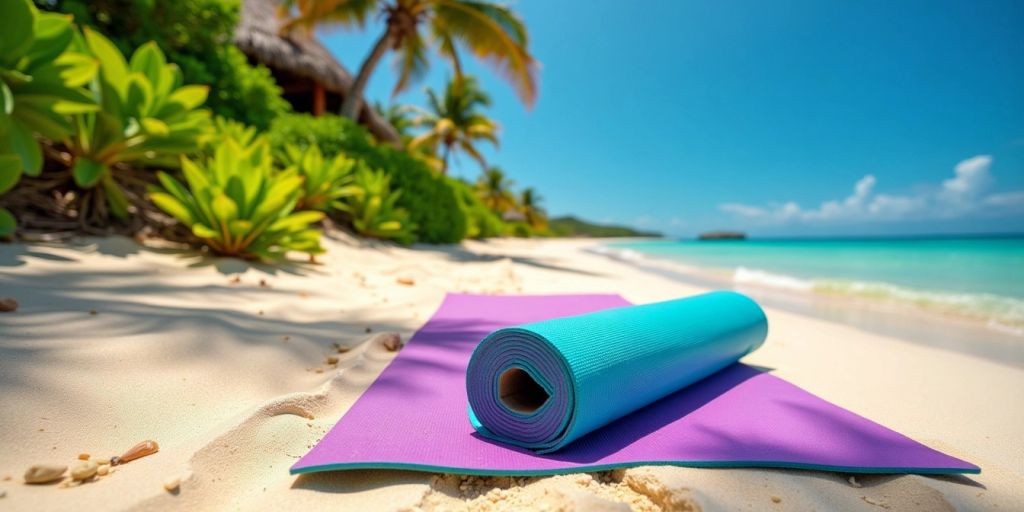
Discover the Best Yoga Mat for Home: Your Ultimate Guide to Comfort and Stability
Choosing the right yoga mat can greatly improve your practice at home. A quality mat provides comfort, stability, and support, making it easier to focus on your poses. This guide will help you understand what to look for in a yoga mat, from materials to thickness, so you can find the best option for your needs.
Key Takeaways
- A good yoga mat offers comfort and support, helping you stay focused during practice.
- Materials like natural rubber and eco-friendly options are great for durability and grip.
- The thickness of your mat can affect cushioning and stability, so choose wisely.
- Look for features like portability and easy cleaning to enhance your yoga experience.
- Regular care and maintenance can extend the life of your mat, ensuring it stays supportive.
Understanding the Importance of a Quality Yoga Mat
A quality yoga mat is essential for a good practice. Choosing the right mat can greatly enhance your comfort and stability during yoga sessions. Here’s why it matters:
Benefits of Using a High-Quality Yoga Mat
- Comfort: A good mat provides the right amount of cushioning, which is important for protecting your joints.
- Safety: High-quality mats offer better grip, reducing the risk of slipping during poses.
- Durability: Investing in a quality mat means it will last longer, saving you money in the long run.
Common Issues with Low-Quality Mats
- Poor Grip: Cheap mats can be slippery, making it hard to maintain balance.
- Lack of Cushioning: Low-quality mats often don’t provide enough support, leading to discomfort.
- Short Lifespan: They wear out quickly, requiring frequent replacements.
How a Good Mat Enhances Your Practice
A good yoga mat creates a designated space for your practice, helping you focus better. It can also prevent injuries by providing the right support.
Remember, a quality mat not only improves your practice but also enhances your overall yoga experience.
In summary, investing in a quality yoga mat is crucial for comfort, safety, and longevity in your practice. It’s worth taking the time to choose wisely!
Top Materials for the Best Yoga Mat for Home
Natural Rubber Mats
Natural rubber mats are popular for their excellent grip and comfort. They provide a non-slip surface, making them ideal for various yoga styles, especially hot yoga. However, they can have a strong odor initially, which fades over time.
Eco-Friendly Options
If you're looking for sustainable choices, consider mats made from eco-friendly materials. These mats are often made from recycled materials or natural substances, reducing environmental impact. They offer decent grip and cushioning, making them suitable for most practitioners.
Synthetic Materials and Their Benefits
Synthetic mats, like those made from PVC or TPE, are often more affordable and lightweight. They can provide good durability and are easy to clean. However, they may not offer the same level of grip as natural rubber mats. Here’s a quick comparison of different materials:
| Material Type | Grip Level | Durability | Eco-Friendliness | Price Range |
|---|---|---|---|---|
| Natural Rubber | High | Moderate | Moderate | $60 - $100 |
| Eco-Friendly | Moderate | Moderate | High | $50 - $90 |
| Synthetic (PVC/TPE) | Moderate | High | Low | $20 - $70 |
Choosing the right material for your yoga mat can significantly enhance your practice. Consider your needs and preferences to find the best fit for you!
Choosing the Right Thickness for Your Yoga Mat

Benefits of Thick Yoga Mats
Thick yoga mats, typically around 6 millimeters or more, provide extra cushioning, making them ideal for those with joint pain or for restorative practices. They offer better insulation against cold floors, enhancing comfort during your sessions.
When to Choose a Thin Mat
Thin mats, usually about 1/8 inch (3.175 mm) thick, are great for active styles of yoga. They allow for better stability and grip, especially during fast-paced movements. If you travel often, a thinner mat is easier to carry.
Balancing Cushion and Stability
Finding the right thickness is crucial for your practice. Here’s a quick guide:
| Thickness (mm) | Best For | Pros | Cons |
|---|---|---|---|
| 1-3 | Travel mats | Lightweight, portable | Less cushioning |
| 3-5 | General practice | Good balance of comfort | May not support joints well |
| 6+ | Restorative or therapeutic yoga | Excellent cushioning | Can be harder to balance on |
Choosing the right thickness can greatly improve your overall yoga experience. Test different options to find what feels best for you!
Features to Look for in the Best Yoga Mat for Home

Grip and Traction
When practicing yoga, having a good grip is essential. A mat with excellent traction helps you hold poses without slipping, especially during challenging sequences. Look for mats that have a textured surface to ensure stability, which is crucial for poses that require balance.
Portability and Weight
If you plan to take your mat to classes or outdoor sessions, consider its weight. Lightweight mats are easier to carry. For example, the Hugger Mugger Earth Elements weighs less than 2.5 pounds, making it a great choice for yogis on the go.
Durability and Longevity
A quality yoga mat should last for years. Look for materials that resist wear and tear. Natural rubber mats, like the Jade Yoga Harmony Mat, are known for their durability and can withstand regular use without losing their grip.
| Feature | Importance | Example Mat |
|---|---|---|
| Grip and Traction | Essential for stability | Jade Yoga Harmony Mat |
| Portability | Easy to carry | Hugger Mugger Earth Elements |
| Durability | Long-lasting performance | Manduka Pro Yoga Mat |
Investing in a quality mat elevates your practice, providing the necessary support for a fulfilling yoga experience.
By focusing on these features, you can find a mat that enhances your yoga journey, ensuring comfort and stability during every session.
Comparing Popular Yoga Mat Brands
When it comes to choosing a yoga mat, brand reputation can play a big role in your decision. Here, we compare some of the most popular yoga mat brands to help you find the right one for your practice.
Manduka vs. Lululemon
- Manduka PRO: Known for its durability and comfort, this mat is often considered the best overall. It has a high price point but is worth the investment for serious yogis.
- Lululemon The Mat 5mm: This mat is versatile and offers a good grip. It’s heavier, which can make it less portable, but many users love its comfort.
Gaiam vs. Jade Yoga
- Gaiam Premium 6mm: A budget-friendly option that provides decent support and grip. It’s a great choice for beginners.
- Jade Harmony: This mat is made from natural rubber and is praised for its grip and comfort. It’s a bit pricier but is often recommended as a top pick for hot yoga.
Budget-Friendly Options
If you’re looking for something more affordable, consider:
- Yoga Accessories 1/4" Extra Thick Deluxe Yoga Mat: A great bargain that holds up well for various practices.
- Gaiam Performance Dry-Grip: Offers good traction at a lower price point, making it a solid choice for those on a budget.
| Brand | Price | Rating |
|---|---|---|
| Manduka PRO | $138 | 91 |
| Lululemon The Mat | $98 | 84 |
| Gaiam Premium 6mm | $35 | 62 |
| Jade Harmony | $92 | 59 |
"A yoga mat should be comfortable and supportive, providing sufficient grip to keep you from slipping."
In conclusion, the best yoga mat for you will depend on your personal needs and preferences. Whether you prioritize comfort, grip, or price, there’s a mat out there that will enhance your practice.
Caring for Your Yoga Mat
Taking care of your yoga mat is essential for keeping it in good shape and ensuring a clean practice space. Here are some tips to help you maintain your mat effectively.
Cleaning and Maintenance Tips
- Wipe down your mat after each use with a damp cloth to remove sweat and dirt. This helps prevent odors and keeps your mat fresh.
- For a deeper clean, you can soak your mat in a bathtub with water and a bit of vinegar. This is especially useful for mats that absorb moisture.
- Some mats are machine washable; if yours is, wash it on a cold gentle cycle to keep it clean without damaging it.
Proper Storage Solutions
- Always roll your mat up loosely and store it in a cool, dry place. Avoid leaving it in direct sunlight or a hot car, as this can damage the material.
- If you have a gym bag with a mat holder, use it to keep your mat safe and easy to carry.
When to Replace Your Mat
- Regularly check your mat for signs of wear, like thinning or fraying edges. If it starts to lose grip or cushioning, it might be time for a new one.
- Taking good care of your yoga mat not only extends its life but also enhances your practice by providing a clean and supportive surface.
A well-maintained yoga mat can last for years. Regular cleaning is essential, especially for mats with open-cell construction that absorb moisture. Some mats are machine washable, while others require spot cleaning. Check the manufacturer's instructions to ensure proper care and extend the lifespan of your mat.
Specialty Yoga Mats for Specific Needs
When it comes to yoga, having the right mat can make a big difference. Here are some specialty mats designed for specific practices:
Mats for Hot Yoga
Hot yoga is intense and requires a mat that can handle heat and sweat. A good hot yoga mat should have excellent grip and be made from materials that can withstand moisture. Look for mats that are thicker and have a non-slip surface to help you stay stable during your practice.
Travel-Friendly Mats
If you’re always on the go, a travel-friendly mat is essential. These mats are lightweight and easy to carry. However, they can be thinner, so make sure they still provide enough support. Some popular options include:
- Jade Yoga Voyager Mat
- Gaiam Foldable Yoga Mat
- Lululemon’s The Lightweight Mat 5mm
Extra-Wide and Long Mats
For those who need more space, extra-wide and long mats are available. These mats provide more room for movement and can be especially helpful for taller individuals or those who prefer more space during their practice. Choosing a unique yoga mat can enhance your practice by providing improved grip, better support, and increased stability.
| Type of Mat | Key Features |
|---|---|
| Hot Yoga Mats | Thick, non-slip, moisture-resistant |
| Travel Mats | Lightweight, portable, thinner |
| Extra-Wide Mats | More space, ideal for taller users |
Remember, investing in a unique yoga mat can elevate your yoga practice significantly. With various options available, every yogi can find a mat that meets their needs and helps achieve fitness goals.
Final Thoughts on Choosing Your Ideal Yoga Mat
Finding the right yoga mat is important for everyone, whether you're new to yoga or have been practicing for a long time. A good mat helps you feel comfortable and stable, making your practice more enjoyable. We hope this guide has given you helpful tips to choose a mat that fits your needs. Remember, a great yoga mat can lead to a more peaceful and kind experience on and off the mat. Happy practicing!
Frequently Asked Questions
What makes a good yoga mat?
A good yoga mat should be comfortable, provide grip to prevent slipping, and be easy to clean. It should also support your body during different poses.
How often should I clean my yoga mat?
You should clean your yoga mat regularly, especially after sweaty sessions. Wipe it down after each use and deep clean it every few weeks.
What thickness of yoga mat is best for me?
The best thickness depends on your practice. Thicker mats offer more cushion, which is great for sensitive joints, while thinner mats provide better stability.
Can I use my yoga mat for other exercises?
Yes! A yoga mat can be used for other workouts like calisthenics, stretching, or even meditation.
How do I store my yoga mat?
Roll your mat loosely with the top side facing out and store it in a cool, dry place. Avoid direct sunlight to keep it in good shape.
When should I replace my yoga mat?
Replace your yoga mat if it shows signs of wear and tear, like cracks or loss of grip, or if it no longer feels supportive during your practice.


